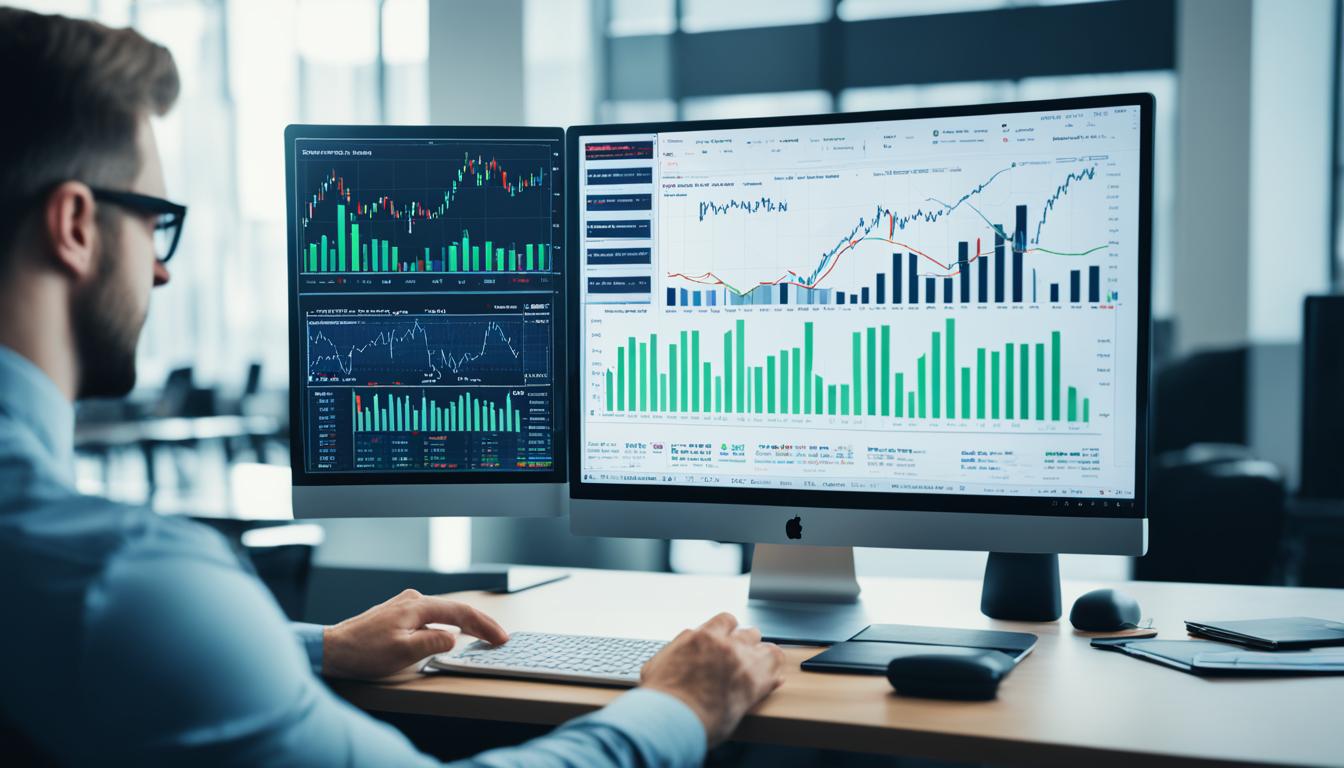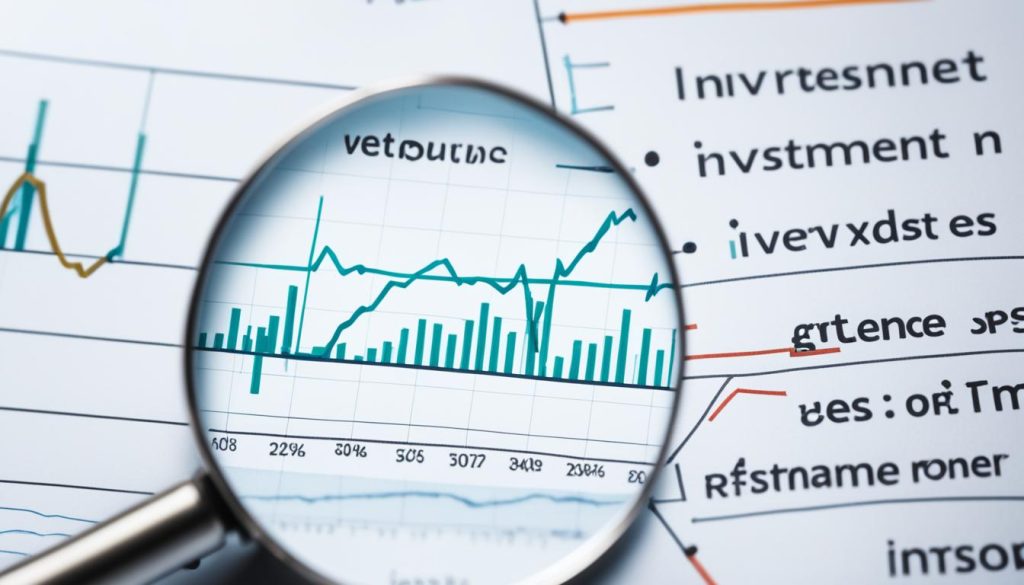Improving your trading strategies can greatly boost your success in the financial markets. Backtesting is a key way to make and check your trading plans. We’ll guide you through the steps to backtest your trading strategies. This ensures you have a solid plan to test your ideas against past market data.
Backtesting means testing your trading strategy with past financial data to see how well it would have done. By looking at how your strategy would have performed in different market conditions, you can make better trading decisions. This helps you manage risks better and might improve your trading results.
Key Takeaways
- Backtesting lets traders check their strategies with past data.
- It’s key for making better decisions and managing risks.
- A systematic approach is vital for testing trading strategies.
- Choosing the right tools and software can boost your backtesting.
- Regular backtesting helps improve your trading methods over time.
Introduction to Backtesting in Trading
Backtesting is a key method for traders and analysts. It tests a trading strategy or model on past data. This helps see if a strategy works before using it in real trading. Good backtesting can make trading better and lower risks.
What is Backtesting?
Backtesting means testing a trading strategy with old market data. It shows how well a strategy would have done before. Traders use this to improve their strategies and make better trading plans.
They apply the strategy’s rules to past data to see what would have happened.
Importance of Backtesting in Trading
Backtesting is very important in trading. It checks if a strategy works before it’s used for real. By testing strategies, traders can avoid big losses by fixing bad parts of their plans.
It also shows what a strategy might do in the future. This helps traders make smart choices and have the right expectations.
Good backtesting makes sure a trading model can do well in different markets. This means it’s more likely to make money regularly.
How to Backtest Trading Strategies
Creating a strong backtesting framework is key for traders who want to improve their strategies. It’s important to know the parts and steps of the process. This makes sure the backtesting goes smoothly and gives useful insights.
Setting Up Your Backtesting Framework
The first step is to set up a detailed framework for backtesting. You need to pick the right backtest software and platforms. These tools should manage different data types and strategies well. They should also be easy to use and have features like customizable metrics and data visualization.
Gathering Historical Data
Having accurate and relevant historical data is the base of good backtesting. This data should cover various market conditions for a full analysis. Here are some sources and types of data to consider:
- Brokerage data: Many brokers offer historical data as part of their service packages.
- Market data providers: Companies like Bloomberg data provide wide-ranging datasets.
- Public domain data: Various websites and financial news portals offer free historical data.
After collecting the data, make sure it’s clean and organized. Fix any gaps or inconsistencies. This step makes your backtesting results more reliable. It helps you understand how to backtest trading strategies well.
Key Metrics to Evaluate in Backtesting
Backtesting a trading strategy involves looking at key metrics. It’s important to know these metrics for accurate analysis and smart decisions.
Win Rate
The win rate shows how often a strategy makes successful trades. It’s found by dividing winning trades by the total trades. A high win rate means more trades are profitable, making the strategy successful.
Risk-Reward Ratio
The risk-reward ratio looks at the gain versus the risk of a strategy. It compares the average profit of wins to the average loss of losses. A good ratio means profits outweigh the risks.
- Average profit per winning trade: This shows the typical gain from profitable trades.
- Average loss per losing trade: This indicates the typical loss from unprofitable trades.
Drawdown Analysis
Drawdown analysis shows a strategy’s potential for loss. It looks at the biggest declines over time, showing the strategy’s risk level. This is key to understanding the worst-case scenarios and preparing for downturns.
Using these backtesting techniques gives traders a full view of a strategy’s performance. It helps in making better decisions and improving trading strategies.
Popular Backtesting Tools and Software
Backtesting is key for traders to improve their strategies and make smart choices. There are many backtesting tools and software out there. Each one has special features for different trading needs.
Choosing the Right Backtesting Platforms
When picking backtesting platforms, traders should think about a few things. They need to match their trading goals. Important things to look at include how easy the platform is to use, how you can change it, how accurate the data is, and how fast it works. Platforms like MetaTrader, TradingView, and QuantConnect offer strong tools for various trading needs and likes.
Features to Look for in Backtesting Software
Good backtest software should have key features for traders to analyze and improve their strategies. Here are the main features to check:
- User Interface: A simple and easy-to-use interface helps with quick navigation and analysis.
- Customization Capabilities: Being able to adjust backtesting settings to fit your trading needs makes your strategy more precise.
- Data Accuracy: Accurate historical data is crucial for trustworthy backtesting results.
- Computational Efficiency: Fast processing times reduce delays and boost productivity.
Below is a table that compares some top backtesting tools. It shows their main features:
| Backtesting Platform | User Interface | Customization | Data Accuracy | Computational Efficiency |
|---|---|---|---|---|
| MetaTrader | Highly Intuitive | Extensive | High | Fast |
| TradingView | Very User-Friendly | Flexible | Excellent | Moderate |
| QuantConnect | Advanced | Highly Tailored | Very High | Fast |
Choosing the right backtesting tools and software is key for traders. It helps them refine their strategies and get reliable results.
Common Backtesting Methodologies
In the world of trading, several backtesting methods help traders check how well a strategy works. These methods, like paper trading and stochastic modeling, have their own benefits and downsides. Knowing how to use these techniques helps traders make better choices.
Paper trading is a common method. It means testing trades on paper to see how they would do in real life. This way, traders can practice without losing real money. But, it doesn’t feel like real trading because there’s no emotional stress.
Simulation is another popular way. It uses software to mimic market conditions and test strategies. This lets traders tweak settings and see how strategies do in different scenarios. But, simulations might not always match real market situations.
Stochastic modeling uses stats to guess the chances of different trading outcomes. It’s great for spotting risks and chances, but you need to know a lot about stats. This method can be hard to use and might need special software and skills.
Here’s a look at how these methods compare:
| Methodology | Advantages | Limitations |
|---|---|---|
| Paper Trading | – No risk to real capital – Helps improve strategy |
– Doesn’t feel like real trading – Just for practice |
| Simulation | – Can change scenarios – Tests many factors |
– Might not be like real markets – Needs software |
| Stochastic Modeling | – Finds risks and chances – Based on stats |
– Needs stats knowledge – Hard to use |
Understanding and using these backtesting methods helps traders deal with trading strategy testing. Each method has its good and bad points. It’s important to pick the right one for your trading style and market conditions.
Interpreting Backtest Results
Understanding your backtest results is key to making sure your trading strategy works well. It helps avoid mistakes and boosts your trading skills.
Avoiding Common Pitfalls
There are a few common mistakes that can lead to wrong backtest results. These include:
- Overfitting: Making your strategy too specific to past data can make it fail in the future.
- Data-snooping Bias: Testing too much on the same data can create patterns that aren’t real.
- Performance Look-ahead Bias: Using future data to test past performance leads to false hopes.
To avoid these problems, be careful with your backtesting. Make sure your results aren’t just luck or based on past events.
Validating Your Trading Strategy
Before trading live, it’s crucial to validate your strategies. Here’s how:
- Out-of-Sample Testing: Use new data not used in the original backtest to check if your strategy works.
- Walk-Forward Analysis: Keep testing and adjusting your strategy over time to see if it keeps working.
- Statistical Significance: Make sure your results are statistically significant to avoid random luck.
- Psychological Readiness: Get ready mentally for real trading, as it’s different from backtesting.
By doing this, traders can lower the risk of mistakes and make their backtesting more reliable.
Conclusion
Learning how to backtest trading strategies is key for traders who want to improve their trading and cut risks. This guide has shown the steps to backtest strategies, from setting up to checking important metrics like win rate and risk-reward ratio. These steps are key for a detailed backtest.
Using top backtesting tools and software makes backtesting easier. It helps traders spot what works and what doesn’t in their strategies. It’s important to know different backtesting methods and understand the results well. This ensures your strategies are strong and dependable.
In summary, backtesting is a must for making and improving trading strategies. It leads to better decisions, more profits, and less risk. Traders should be thorough and critical when backtesting. Adding backtesting to your trading tools is a step towards lasting success in the financial markets.
FAQ
What is backtesting in trading?
Backtesting is when traders test a trading strategy using past market data. This checks if the strategy works before using it in real trading.
Why is backtesting important for traders?
Backtesting is key because it checks if a trading strategy is reliable. It helps traders know how profitable and risky a strategy could be.
How do you set up a backtesting framework?
To set up backtesting, pick the right software or platform. Define your trading strategy and gather historical data. Make sure the data is good quality. Then, test your strategy against the data.
What historical data is needed for backtesting?
Traders need historical price and volume data for backtesting. They also might use economic indicators or news, depending on their strategy.
What is the win rate in backtesting analysis?
The win rate shows how often a trading strategy wins trades. It’s a key measure of strategy success.
What is the risk-reward ratio in trading strategy backtesting?
The risk-reward ratio compares the risk to potential reward in a strategy. A good ratio means the reward is greater than the risk.
What is drawdown analysis in backtesting techniques?
Drawdown analysis looks at the lowest point of a trading account’s value. It shows the risk and volatility of a strategy.
How do you choose the right backtesting platforms?
Choose a backtesting platform based on its interface, customization, data quality, speed, and features. Popular choices include MetaTrader, TradingView, and NinjaTrader.
What features should you look for in backtesting software?
Look for a user-friendly interface, customization options, accurate data, and fast processing. Useful extras include visualization tools, platform integration, and detailed reports.
What are the common backtesting methodologies?
Common methods are paper trading, simulation, and stochastic modeling. Each has its own benefits and drawbacks, depending on the strategy’s needs.
How do you interpret backtest results effectively?
To understand backtest results, watch out for pitfalls like overfitting and data-snooping bias. Make sure your strategy is statistically significant and mentally prepared for real trading.
What are the common pitfalls to avoid in backtesting?
Avoid overfitting and data-snooping bias. These issues can make backtesting results misleading.






